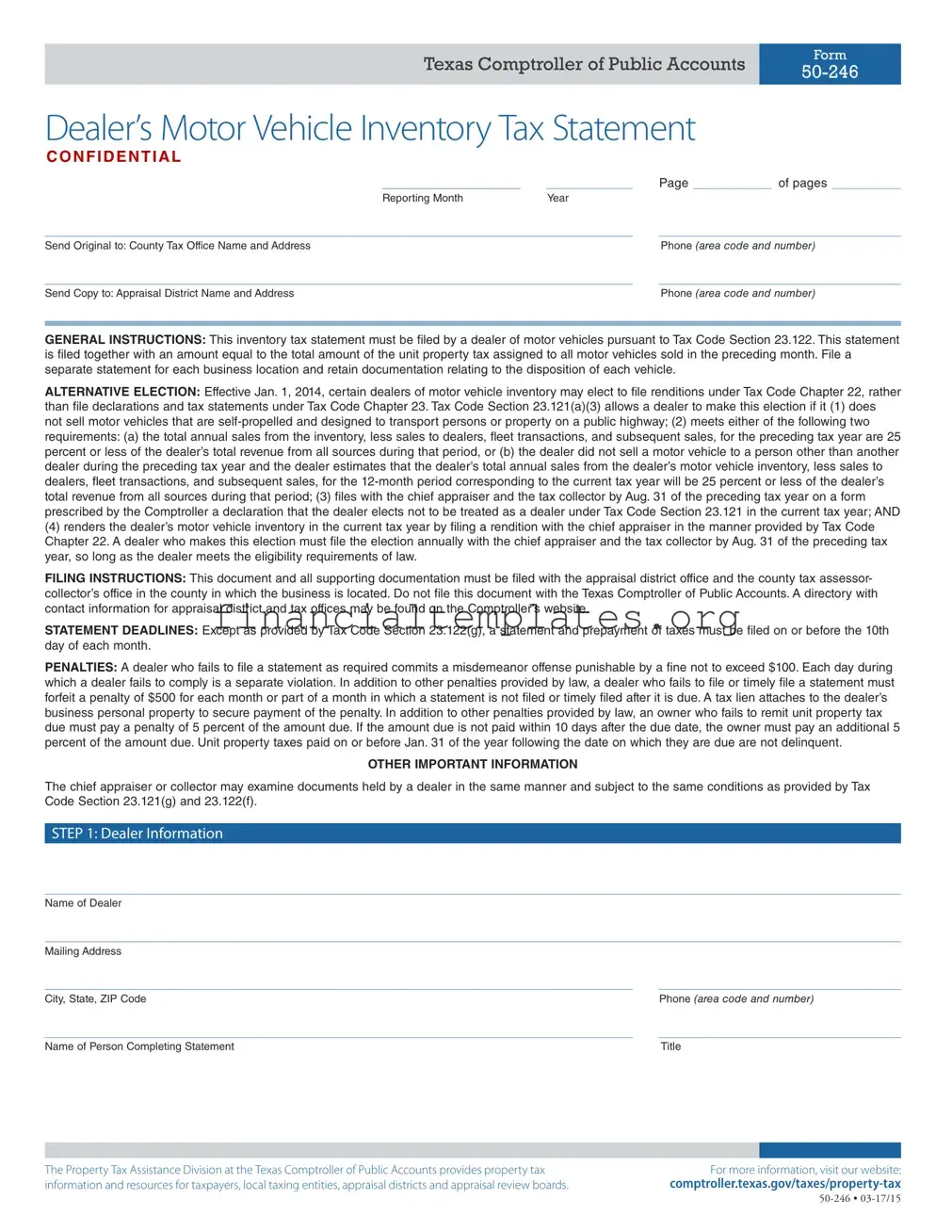|
Texas Comptroller of Public Accounts |
Form |
|
50-246 |
|
|
Dealer’s Motor Vehicle Inventory Tax Statement
CONFIDENT IAL
________________ |
__________ |
Page _________ of pages ________ |
Reporting Month |
Year |
|
____________________________________________________________________ |
____________________________ |
Send Original to: County Tax Office Name and Address |
|
Phone (area code and number) |
____________________________________________________________________ |
____________________________ |
Send Copy to: Appraisal District Name and Address |
|
Phone (area code and number) |
GENERAL INSTRUCTIONS: This inventory tax statement must be filed by a dealer of motor vehicles pursuant to Tax Code Section 23.122. This statement is filed together with an amount equal to the total amount of the unit property tax assigned to all motor vehicles sold in the preceding month. File a separate statement for each business location and retain documentation relating to the disposition of each vehicle.
ALTERNATIVE ELECTION: Effective Jan. 1, 2014, certain dealers of motor vehicle inventory may elect to file renditions under Tax Code Chapter 22, rather than file declarations and tax statements under Tax Code Chapter 23. Tax Code Section 23.121(a)(3) allows a dealer to make this election if it (1) does not sell motor vehicles that are self-propelled and designed to transport persons or property on a public highway; (2) meets either of the following two requirements: (a) the total annual sales from the inventory, less sales to dealers, fleet transactions, and subsequent sales, for the preceding tax year are 25 percent or less of the dealer’s total revenue from all sources during that period, or (b) the dealer did not sell a motor vehicle to a person other than another dealer during the preceding tax year and the dealer estimates that the dealer’s total annual sales from the dealer’s motor vehicle inventory, less sales to dealers, fleet transactions, and subsequent sales, for the 12-month period corresponding to the current tax year will be 25 percent or less of the dealer’s total revenue from all sources during that period; (3) files with the chief appraiser and the tax collector by Aug. 31 of the preceding tax year on a form prescribed by the Comptroller a declaration that the dealer elects not to be treated as a dealer under Tax Code Section 23.121 in the current tax year; AND
(4)renders the dealer’s motor vehicle inventory in the current tax year by filing a rendition with the chief appraiser in the manner provided by Tax Code Chapter 22. A dealer who makes this election must file the election annually with the chief appraiser and the tax collector by Aug. 31 of the preceding tax year, so long as the dealer meets the eligibility requirements of law.
FILING INSTRUCTIONS: This document and all supporting documentation must be filed with the appraisal district office and the county tax assessor- collector’s office in the county in which the business is located. Do not file this document with the Texas Comptroller of Public Accounts. A directory with contact information for appraisal district and tax offices may be found on the Comptroller’s website.
STATEMENT DEADLINES: Except as provided by Tax Code Section 23.122(g), a statement and prepayment of taxes must be filed on or before the 10th day of each month.
PENALTIES: A dealer who fails to file a statement as required commits a misdemeanor offense punishable by a fine not to exceed $100. Each day during which a dealer fails to comply is a separate violation. In addition to other penalties provided by law, a dealer who fails to file or timely file a statement must forfeit a penalty of $500 for each month or part of a month in which a statement is not filed or timely filed after it is due. A tax lien attaches to the dealer’s business personal property to secure payment of the penalty. In addition to other penalties provided by law, an owner who fails to remit unit property tax due must pay a penalty of 5 percent of the amount due. If the amount due is not paid within 10 days after the due date, the owner must pay an additional 5 percent of the amount due. Unit property taxes paid on or before Jan. 31 of the year following the date on which they are due are not delinquent.
OTHER IMPORTANT INFORMATION
The chief appraiser or collector may examine documents held by a dealer in the same manner and subject to the same conditions as provided by Tax Code Section 23.121(g) and 23.122(f).
STEP 1: Dealer Information
___________________________________________________________________________________________________
Name of Dealer
___________________________________________________________________________________________________
Mailing Address
____________________________________________________________________ |
____________________________ |
City, State, ZIP Code |
Phone (area code and number) |
____________________________________________________________________ |
____________________________ |
Name of Person Completing Statement |
Title |
The Property Tax Assistance Division at the Texas Comptroller of Public Accounts provides property tax |
For more information, visit our website: |
information and resources for taxpayers, local taxing entities, appraisal districts and appraisal review boards. |
comptroller.texas.gov/taxes/property-tax |



